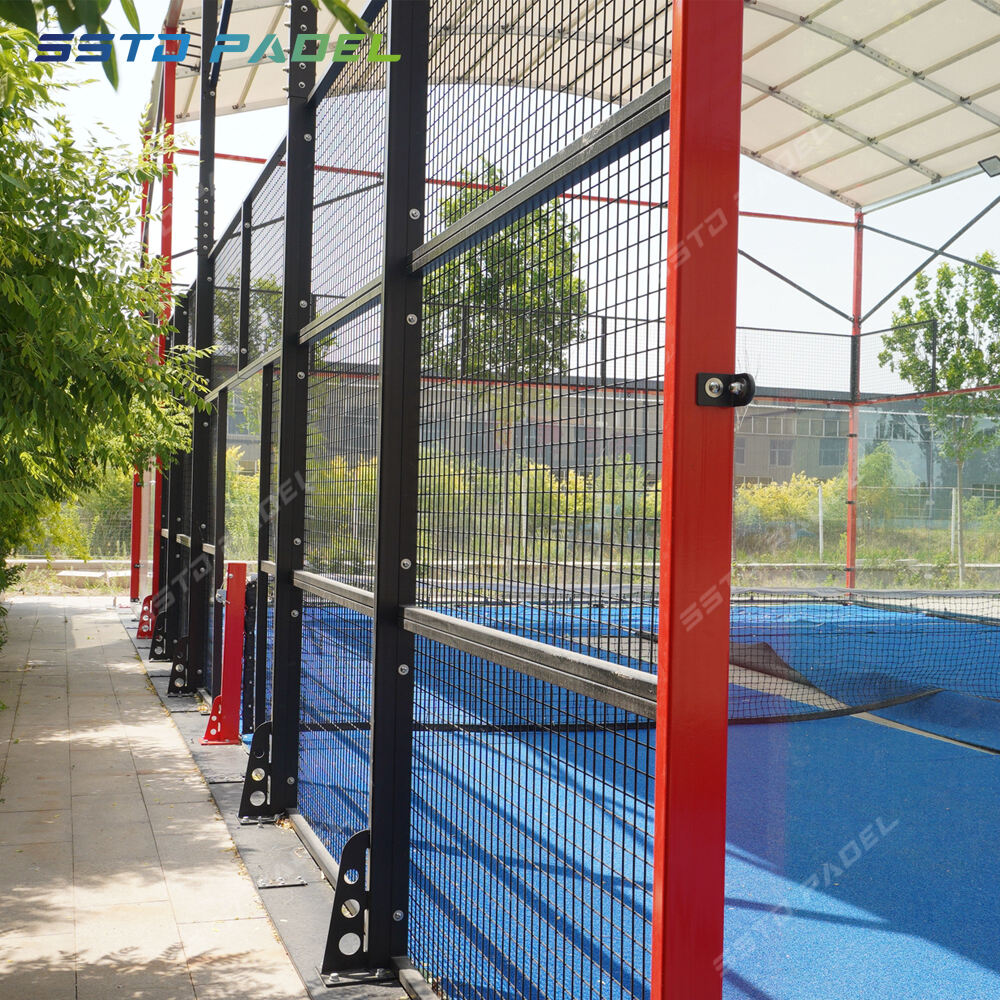บทนำ
ปาเดลปิงปอง รวมความตื่นเต้นของเทนนิสเข้ากับจังหวะที่รวดเร็วของเทเบิลเทนนิส มันเป็นกีฬาที่ทำให้คุณต้องตื่นตัวและรับประกันความสนุก เพื่อที่จะสนุกกับมันอย่างแท้จริง คุณต้องรู้กฎของพาเดล กฎเหล่านี้ช่วยให้การเล่นเป็นธรรมและช่วยให้คุณพัฒนาทักษะของคุณในขณะที่สนุกสนาน
กฎของพาเดล: การเล่นพื้นฐาน
กฎการเสิร์ฟ
การเสิร์ฟในพาเดลนั้นตรงไปตรงมา แต่มีบางกฎสำคัญที่คุณต้องปฏิบัติตาม ก่อนอื่นเสิร์ฟต้องเป็นแบบใต้มือเสมอ ลูกบอลต้องเด้งลงบนพื้นก่อนที่คุณจะตีมัน ตรวจสอบให้แน่ใจว่ามันตกลงในกล่องบริการของฝ่ายตรงข้ามในแนวทแยงมุมจากคุณ หากมันโดนเน็ตและยังตกลงในกล่องที่ถูกต้อง นั่นคือการเสิร์ฟที่ถูกต้อง และคุณสามารถเสิร์ฟอีกครั้งได้
คุณยังต้องยืนอยู่หลังเส้นบริการเมื่อทำการเสิร์ฟ อย่าเดินข้ามมันจนกว่าคุณจะตีลูกบอล หากคุณพลาดการเสิร์ฟสองครั้งติดต่อกัน ฝ่ายตรงข้ามจะได้คะแนน ฝึกการเสิร์ฟของคุณเพื่อให้คุ้นเคยกับกฎเหล่านี้ นี่เป็นวิธีที่ดีในการเริ่มต้นอย่างแข็งแกร่งในเกมใด ๆ
พื้นฐานการให้คะแนน
ปาเดลใช้ระบบคะแนนเดียวกับเทนนิส คุณจะเล่นคะแนนในลำดับ 15, 30, 40 และจากนั้นเป็นคะแนนเกม หากทั้งสองทีมถึง 40 จะเรียกว่าเดซ คุณต้องทำคะแนนสองคะแนนติดต่อกันเพื่อชนะจากเดซ แมตช์มักจะเล่นเป็นดีที่สุดจากสามเซต และคุณต้องชนะหกเกมเพื่อชนะเซต
แนวทางการเล่นทั่วไป
กฎของปาเดลส่งเสริมการเล่นที่รวดเร็วและน่าตื่นเต้น คุณสามารถตีลูกบอลหลังจากที่มันเด้งครั้งเดียวหรือโดยตรงในอากาศ ใช้ผนังให้เป็นประโยชน์ แต่จำไว้ว่าลูกบอลต้องกระทบพื้นในฝั่งของคู่ต่อสู้ก่อนที่จะสัมผัสกับผนัง รักษาลูกบอลให้อยู่ในเกมและหลีกเลี่ยงการตีออกนอกขอบเขต
การทำงานเป็นทีมมีความสำคัญในแมตช์คู่ สื่อสารกับคู่ของคุณและคอยระวังตำแหน่งของคุณ การปฏิบัติตามแนวทางเหล่านี้จะช่วยให้คุณสนุกกับเกมและพัฒนาทักษะของคุณ
กฎของปาเดล: สนามและอุปกรณ์
ขนาดสนาม
ตัว สนามพาดเล มีขนาดเล็กกว่าคอร์ตเทนนิส แต่มีคุณสมบัติที่เป็นเอกลักษณ์ซึ่งทำให้เกมน่าตื่นเต้น มันมีความยาว 20 เมตร และกว้าง 10 เมตร โดยมีตาข่ายแบ่งครึ่งสนาม สี่เหลี่ยมรอบคอร์ตเป็นส่วนสำคัญของเกม โดยทั่วไปทำจากกระจกหรือผ้าใยสังเคราะห์ และอนุญาตให้คุณเด้งลูกบอลออกจากพวกเขาในระหว่างการเล่น
คุณจะสังเกตเห็นเส้นบริการที่ทำเครื่องหมายไว้บนคอร์ต ซึ่งช่วยแนะนำว่าการเสิร์ฟควรลงที่ไหน การออกแบบที่ปิดล้อมช่วยให้ลูกบอลอยู่ในเกมได้นานขึ้น สร้างการเล่นที่น่าตื่นเต้น หากคุณเป็นมือใหม่ในเกมนี้ ให้ใช้เวลาสักครู่เพื่อทำความคุ้นเคยกับรูปแบบของคอร์ต มันจะช่วยให้คุณเข้าใจวิธีการใช้พื้นที่ได้อย่างมีประสิทธิภาพ
อุปกรณ์ที่จำเป็น
ในการเล่นพาเดล คุณไม่จำเป็นต้องมีอุปกรณ์มากมาย แต่การมีอุปกรณ์ที่เหมาะสมทำให้แตกต่างอย่างมาก ก่อนอื่นคุณจะต้องมีไม้พาเดล ไม้พาเดลแตกต่างจากไม้เทนนิส โดยไม้พาเดลมีลักษณะเป็นของแข็ง มีรูพรุน และมีขนาดเล็กกว่าหน่อย มันถูกออกแบบมาเพื่อการควบคุมและความแม่นยำที่ดีกว่า
ต่อไปนี้ให้หยิบลูกปาเดล ลูกเหล่านี้ดูเหมือนลูกเทนนิสแต่มีแรงดันน้อยกว่า ทำให้มันเด้งแตกต่างกัน เสื้อผ้ากีฬาแบบสบายและรองเท้าที่ไม่ลื่นก็สำคัญเช่นกัน รองเท้าที่มีการยึดเกาะดีช่วยให้คุณเคลื่อนที่ได้อย่างรวดเร็วและปลอดภัยในสนาม
หากคุณเพิ่งเริ่มต้น คุณสามารถเช่าอุปกรณ์ที่คลับปาเดลส่วนใหญ่ได้ เมื่อคุณติดใจในเกม การลงทุนในอุปกรณ์ของตัวเองเป็นความคิดที่ดี
กฎของปาเดล: ระบบการให้คะแนน
วิธีการให้คะแนน
การให้คะแนนในปาเดลอาจดูยุ่งยากในตอนแรก แต่จริงๆ แล้วมันค่อนข้างง่ายเมื่อคุณเข้าใจมัน เพียงแค่เหมือนกับเทนนิส คุณจะให้คะแนนในลำดับนี้: 15, 30, 40 และจากนั้นก็เป็นคะแนนเกม หากทั้งสองทีมถึง 40 จะเรียกว่าเดซูส เพื่อที่จะชนะจากเดซูส คุณต้องทำคะแนนสองคะแนนติดต่อกัน
คุณจะได้รับคะแนนเมื่อคู่ต่อสู้ทำผิดพลาด ตัวอย่างเช่น หากพวกเขาตีลูกออกนอกเขต ไม่สามารถส่งคืนได้ หรือปล่อยให้ลูกเด้งสองครั้งในฝั่งของพวกเขา คุณจะได้คะแนน คุณยังสามารถทำคะแนนได้หากพวกเขาตีลูกเข้าตาข่ายหรือทำผิดกฎการเสิร์ฟใดๆ
ส่วนที่ดีที่สุด? ทุกการร rally มีความหมาย ไม่ว่าคุณจะเสิร์ฟหรือรับ คุณมีโอกาสทำคะแนนเสมอ นี่ทำให้เกมน่าตื่นเต้นและรวดเร็ว
การชนะเกมหรือแมตช์
เพื่อชนะเกม คุณต้องทำคะแนนให้ได้สี่คะแนนและนำหน้าอย่างน้อยสองคะแนน หากคะแนนเสมอกันที่เดือด คุณจะต้องชนะสองคะแนนติดต่อกันเพื่อคว้าเกม
เซตประกอบด้วยหกเกม เพื่อชนะเซต คุณต้องนำหน้าอย่างน้อยสองเกม หากทั้งสองทีมชนะหกเกมเท่ากัน คุณจะต้องเล่นการตัดสินเพื่อกำหนดเซต แมตช์มักจะเล่นเป็นดีที่สุดจากสามเซต
การเข้าใจกฎการให้คะแนนเหล่านี้ช่วยให้คุณมีสมาธิและวางกลยุทธ์ได้ดีขึ้นในระหว่างเกม ด้วยการฝึกฝน คุณจะพบว่าตัวเองติดตามคะแนนได้เหมือนมืออาชีพ
กฎของ Padel: กลไกการเล่นและกลยุทธ์
การจัดตำแหน่งผู้เล่น
การวางตำแหน่งเป็นสิ่งสำคัญในพาเดล คุณและคู่ของคุณควรทำงานเป็นทีมเพื่อปกคลุมสนามอย่างมีประสิทธิภาพ เริ่มต้นด้วยการยืนเคียงข้างกันใกล้เส้นฐานเมื่อรับเสิร์ฟ นี่จะทำให้คุณมีตำแหน่งป้องกันที่มั่นคง เมื่อการเล่นดำเนินไป ให้เคลื่อนที่ไปข้างหน้า toward the net การควบคุมเน็ตเป็นข้อได้เปรียบที่สำคัญเพราะมันช่วยให้คุณสามารถตีลูกที่มีความก้าวร้าวมากขึ้น
หลีกเลี่ยงการยืนใกล้เกินไปกับคู่ของคุณ แยกออกเพื่อปกคลุมพื้นที่มากขึ้นและลดโอกาสในการทิ้งพื้นที่ว่างให้คู่แข่งใช้ประโยชน์จากมัน ควรอยู่ในสภาพตื่นตัวเสมอและปรับตำแหน่งของคุณตามการเคลื่อนไหวของลูก ลูกที่มีตำแหน่งดีจะทำให้คุณพร้อมสำหรับการตีลูกใด ๆ และช่วยให้คุณควบคุมเกมได้
กลยุทธ์พื้นฐานสำหรับผู้เริ่มต้น
หากคุณเป็นมือใหม่ในพาเดล ให้มุ่งเน้นที่ความสม่ำเสมอ พยายามรักษาลูกให้เล่นอยู่ในสนามให้มากที่สุด หลีกเลี่ยงการตีลูกที่มีความเสี่ยงซึ่งอาจออกนอกสนาม ใช้ผนังให้เป็นประโยชน์ มันสามารถช่วยให้คุณคืนลูกที่ยากและทำให้การเล่นยังคงดำเนินต่อไป
การสื่อสารกับคู่ของคุณเป็นกุญแจสำคัญ เรียกชื่อว่าใครจะรับลูกบอลเพื่อหลีกเลี่ยงความสับสน ฝึกซ้อมการยิงง่ายๆ เช่น ลูกลอยและลูกวอลเลย์เพื่อสร้างความมั่นใจ กลยุทธ์เหล่านี้จะช่วยให้คุณสนุกกับเกมในขณะที่พัฒนาทักษะของคุณ
เคล็ดลับขั้นสูงสำหรับการเล่นแข่งขัน
สำหรับผู้เล่นที่มีประสบการณ์ กลยุทธ์จะมีความสำคัญมากขึ้น ใช้การยิงที่มีมุมเพื่อบังคับให้คู่ต่อสู้ของคุณออกจากตำแหน่ง เปลี่ยนแปลงการยิงของคุณเพื่อให้พวกเขาคาดเดาไม่ถูก การรวมกันของลูกลอย ลูกตีแรง และลูกตกสามารถทำให้จังหวะของพวกเขาถูกขัดจังหวะ
การคาดการณ์เป็นทักษะที่สำคัญอีกอย่างหนึ่ง สังเกตคู่ต่อสู้ของคุณอย่างใกล้ชิดเพื่อคาดการณ์การเคลื่อนไหวถัดไปของพวกเขา สิ่งนี้จะให้คุณได้เปรียบในเสี้ยววินาทีในการตอบสนอง สุดท้ายนี้ ให้มุ่งมั่นที่จะควบคุมตาข่าย การชนะการต่อสู้ที่ตาข่ายมักจะตัดสินผลการแข่งขัน
เคล็ดลับจากมืออาชีพ: ฝึกซ้อมการฝึกที่มุ่งเน้นไปที่การเคลื่อนไหวของเท้าและเวลาในการตอบสนอง สิ่งเหล่านี้จะช่วยเพิ่มทักษะของคุณและให้คุณได้เปรียบในการเล่นแข่งขัน
กฎของปาเดล: การฟาวล์ที่พบบ่อย
การละเมิดการเสิร์ฟ
การเสิร์ฟอาจดูเหมือนง่าย แต่ก็ง่ายที่จะทำผิดพลาดหากคุณไม่ระมัดระวัง นี่คือข้อผิดพลาดในการเสิร์ฟที่พบบ่อยที่ควรระวัง:
- ข้อผิดพลาดในการวางเท้า : หากคุณก้าวข้ามเส้นบริการก่อนที่จะตีลูกบอล นั่นคือข้อผิดพลาด ให้ยืนอยู่หลังเส้นจนกว่าการเสิร์ฟของคุณจะเสร็จสิ้น
- การเด้งไม่ถูกต้อง : ลูกบอลต้องเด้งบนพื้นดินก่อนที่คุณจะตีมัน การข้ามขั้นตอนนี้จะส่งผลให้เกิดข้อผิดพลาด
- พื้นที่เป้าหมายที่ผิด : การเสิร์ฟของคุณต้องตกลงในกล่องบริการที่ถูกต้องซึ่งอยู่เฉียงข้ามจากคุณ หากไม่เป็นเช่นนั้น คู่ต่อสู้ของคุณจะได้คะแนน
เคล็ดลับ : ฝึกการเสิร์ฟของคุณอย่างสม่ำเสมอ การเสิร์ฟที่สม่ำเสมอสามารถให้คุณได้เปรียบและช่วยให้คุณหลีกเลี่ยงข้อผิดพลาดเหล่านี้
การละเมิดกฎการเล่น
ในระหว่างการเล่น คุณต้องปฏิบัติตามกฎเพื่อให้เกมยุติธรรม นี่คือการละเมิดที่พบบ่อย:
- การเด้งสองครั้ง : หากลูกบอลเด้งสองครั้งในฝั่งของคุณ คู่ต่อสู้ของคุณจะชนะคะแนน
- นอกเขต : การตีลูกบอลออกนอกขอบเขตของสนามถือเป็นข้อผิดพลาด
- การใช้ผนังไม่ถูกต้อง คุณสามารถใช้ผนังได้ แต่ลูกบอลต้องกระทบพื้นในฝั่งของคู่ต่อสู้ก่อน
ตั้งสมาธิระหว่างการเล่นแลกเปลี่ยน ลูกเล่นที่รวดเร็วและการตัดสินใจที่ดีสามารถช่วยให้คุณหลีกเลี่ยงข้อผิดพลาดเหล่านี้ได้
ความปลอดภัยและมารยาทในสนาม
ความปลอดภัยมีความสำคัญไม่แพ้ทักษะในปาเดล ปฏิบัติตามแนวทางเหล่านี้เพื่อให้เกมสนุกสนานสำหรับทุกคน:
- หลีกเลี่ยงการสัมผัสตาข่าย การสัมผัสตาข่ายด้วยไม้ตีหรือร่างกายของคุณถือเป็นการฟาวล์ หลีกเลี่ยงการเข้าใกล้ในระหว่างการเล่น
- เคารพพื้นที่ส่วนตัว คำนึงถึงคู่ของคุณและคู่ต่อสู้ หลีกเลี่ยงการแกว่งไม้ตีอย่างไม่ระมัดระวัง
- แจ้งอันตราย หากลูกบอลหรืออุปกรณ์ขวางทาง ให้หยุดเกมและจัดการกับปัญหา
หมายเหตุ การมีน้ำใจนักกีฬาเป็นสิ่งสำคัญ เคารพกฎและเพื่อนร่วมเล่นเพื่อสร้างบรรยากาศการเล่นที่ดี
ปาเดลปิงปองเรียนรู้ได้ง่ายและเต็มไปด้วยความตื่นเต้น คุณมีทั้งกฎ การทำคะแนน และกลยุทธ์แล้ว—ตอนนี้ถึงเวลาออกไปเล่นในสนาม!
- ทำไมต้องรอ? จับไม้ตี เชิญเพื่อนบางคน และเริ่มเล่นกันเถอะ
- มันไม่ใช่แค่เกม; มันเป็นประสบการณ์ทางสังคม
เคล็ดลับ : ฝึกฝนบ่อยๆ และสนุกกับทุกการเล่น!

